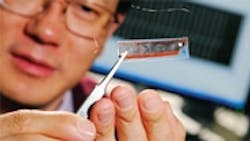Self-powered nanosensors
A new generator and nanoscale sensors are creating possibilities for very small battery-free sensing devices that can be powered by mechanical energy harvested from the environment. Energy sources could include the motion of tides, sonic waves, mechanical vibration, flags flapping in the wind, pressure from hiking shoes, or the movement of clothing. By combining a new generation of piezoelectric nanogenerators with two types of nanowire sensors, researchers at Georgia Tech, Atlanta, have created what are believed to be the first self-powered nanometer-scale sensing devices that can measure pH or detect ultraviolet light using electrical current produced from mechanical energy in the environment.
Based on arrays containing as many as 20,000 zinc oxide nanowires in each nanogenerator, the devices can produce up to 1.2 V of output voltage, and are fabricated with a chemical process designed to facilitate low-cost manufacture on flexible substrates. Details of the improved nanogenerator and self-powered nanosensors were reported in the March 28 issue of Nature Nanotechnology.
For the past five years, engineering professor Zhong Lin Wang's research team has been developing nanoscale generators that use the piezoelectric effect, which produces electrical charges when wires made from zinc oxide are subjected to strain. The strain can be produced by simply flexing the wires, and current from many wires can be combined to power small devices. The research effort has recently focused on increasing the amount of current and voltage generated and on making the devices more robust.
In the paper, Wang and his collaborators report on a new configuration for the nanowires that embeds both ends of the tiny structures in a polymer substrate. The wires can then generate current as they are compressed in a flexible nanogenerator enclosure, eliminating the contact with a metallic electrode that was required in earlier devices. Because the generators are completely enclosed, they can be used in a variety of environments. For more information, visit www.gatech.edu.
